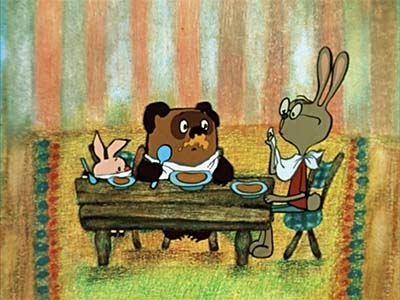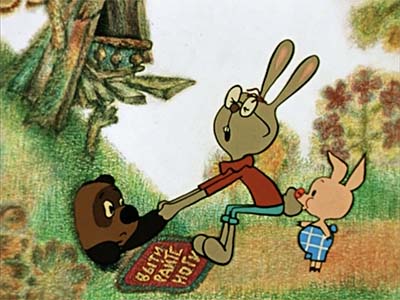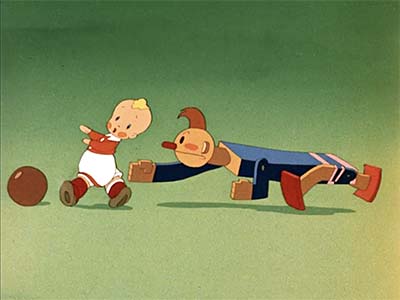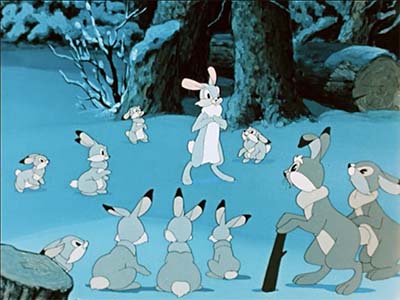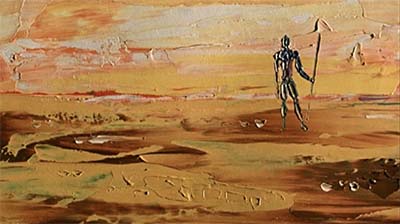People who aren’t members of Animation Resources don’t understand how comprehensive our Reference Packs are. Over the next couple of weeks, we will be posting what each section of our current RefPack looks like. If you are a member of Animation Resources, click on this post to go to the Members Only page. If you aren’t a member yet, today is the perfect time to join! Our current Reference Pack is one of our best yet, and General and Student Members get access to a special Bonus Archive with even more material from past Reference Packs.
What are you waiting for?![]()
JOIN TODAY!
https://animationresources.org/membership/levels/

The world of animation is much bigger than it might appear to us at first glance. We are all familiar with the films we grew up with, but Hollywood wasn’t the only place that produced great cartoons… Poland, Japan, Russia, China and Europe all have their own traditions and a rich history of animated film making. Animation Resources’ archive contains many foreign films that are rarely seen in the United States. We feature a sampling of interesting animation from around the world in each Reference Pack.
Winnie The Pooh episode 02
![]()
Fyodor Khitruk / Soyuzmultfilm, Russia / 1971
Download this article
This time, Animation Resources is continuing Fyodor Khitruk’s series of films based on “Winnie The Pooh” with the second episode, Winnie The Pooh Pays A Visit. You’ll find that this series is quite different than the Disney version. Khitruk omits Christopher Robin and focuses solely on Winnie the Pooh and his friends. He said that he made this choice because he didn’t want the characters to be subordinate to a human character; and it’s clear that Khitruk’s choice was a good one. On a visit to California, Khitruk paid a visit to the Disney Studios where he met Woolie Reitherman, the director who had won an Oscar for Disney’s version of “Winnie The Pooh”. Reitherman admitted to Khitruk that he liked Khitruk’s films better than his own.
The story of the second short film in the series follows the same plot as the second half of Disney’s first Winnie The Pooh film… Winnie The Pooh And The Honey Tree. If you have seen that film, you will have no problem following along, even if you don’t speak Russian. Like the Disney film, Pooh and Piglet visit Rabbit, and Pooh proceeds to eat all of his honey. When it comes time to leave, Pooh gets stuck in the door. Pooh is extricated in a different way in Khitruk’s film.
Although the pacing of the film is leisurely, the timing is still sharp. Khitruk focuses on “micro gags” and quick changes of expression that use personality to keep the audience engaged with the characters. The style is charming and disarmingly simple, much more in keeping with the spirit of the original book than Disney’s version. There is one more films in this series. We will have that for you in RefPack047.
MP4 Video File / SD / 09:55 / 146 MB Download

An Unusual Match
![]()
Mstislav Pashchenko, Boris Dyozhkin / Soyuzmultfilm, Russia / 1955
In the years immediately following the end of WWII, Russian animation progressed rapidly. By the mid 1950s, the quality level had caught up with the peak standards in the West. One of the most popular films produced by Soyuzmultfilm during this period was "An Unusual Match". In the past two Reference Packs we shared "Goal! Goal" and "A Match Revenge" which dealt with ice hockey. This film involves toys coming to life and competing in a soccer match.
It’s midnight in a toy shop and all the toys have come to life. The dolls and stuffed animals play while the wooden toys are tied up in a box. A rabbit comes to their rescue and lets them out, and the wooden toys swagger around boasting and playing pool. The dolls decide to call the wooden toys’ bluff and challenge them to a soccer match. The wooden toys try to cheat any way they can, but in the end, the dolls win decisively, proving that good sportsmanship always comes out on top.
Hollywood animation had penetrated into Russia in the pre-war years and animators there took notice of the styles and techniques from America. The earliest post-war films produced in Russia leaned on rotoscoping, but it didn’t take long for them to move past mechanics and begin animating without tracing. This film is clearly influenced by Disney’s Silly Symphonies, not only because of the "toys come to life" trope, but in background and color styling as well. The music was composed and conducted by the famous Russian composer, Aram Kachaturian, whose "Sabre Dance" was a staple in soundtracks of golden age cartoons. Soyuzmultfilm in this era was producing films that were second to none.
MP4 Video File / SD / 20:38 / 647 MB Download

A Brave Hare
![]()
Ivan Ivanov-Vano / Soyuzmultfilm, Russia / 1955
During the 1950s, Soyuzmultfilm produced dozens of films based on Russian fables and folk tales featuring forest animals. Designed to teach morals to children, they began to define a sense of cultural uniqueness for Russian animation. Even though the style of the films resembled American cartoons, the content was distinctly Russian. This film has a live action wrap-around which resembles some of the scenes in Song Of The South, but it is doubtful that the animators had seen that film. The Iron Curtain had descended, and Western films, music and books were not freely available in the Russian block.
The film begins with an old woman and her two grandchildren. The boy and girl argue about who is braver; but when they see a mouse, both are terrified. The grandmother scolds them for being afraid and tells them the story of a little rabbit who was afraid of everything— a fluttering bird, a lump of snow falling from a tree or the snap of a twig. The other animals laughed and made fun of him. All at once, he got tired of fear and decided to announce to the world that he was the bravest of all, not afraid of anyone or anything. This made the animals laugh even harder and dance with joy.
From deep in the forest, a wolf spied the animals and began to stalking the brave hare. When he saw the wolf, the hare panicked and leapt into the air, landing on the wolf’s back. This terrified the wolf and the wolf and hare ran for their lives in opposite directions. With the wolf gone, the animals came out of hiding and looked for the brave hare. The searched everywhere without luck, but finally a little bird lead them to where the hare was hiding. At first the hare was timid, but the other animals thanked him for being so brave and chasing the wolf away. The brave hare stood tall and said, "Of course, you cowards! I’m the bravest of all!"
The pantomime animation of the rabbits in this film is brilliant. Even without understanding Russian, you can clearly understand the attitudes and reactions. Even better are the backgrounds— they are atmospheric and as gorgeous as any in Bambi.
MP4 Video File / SD / 16:35 / 278 MB Download
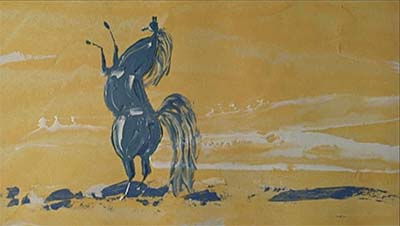
The Horse
![]()
Witold Giersz / Poland / 1967
A couple of years ago, we shared a film called "A Little Western" by Witold Giersz. It’s time to share another film by this one-of-a-kind Polish animator.
Giersz admired impressionist painters, and Vincent Van Gogh in particular. In this style of painting, the paint isn’t mixed or blended, it is applied in dimensional globs of solid color, referred to as impasto. A color didn’t exist on its own, it depended on the colors around it to define its hue and shade. The colors combined to create dimension and space, and the surface texture added a dimension of its own. Giersz animated by applying oil paint on glass with a palette knife. This allowed him to build up impasto and scrape off paint to make an image move.
If you still frame on any given frame of "Horse," the image might seem flat and featureless, with simple bold primary colors. But behind that simple surface, there is a magic trick being performed. If you play the film in motion, those flat shapes turn into solid volumetric forms. How can it be two dimensional and three dimensional at the same time? The secret is the fourth dimension of time.
Ward Kimball once said that the art of animation doesn’t exist in individual drawings. The art is in the differences between the drawings. The way those flat shapes change from one to another is the secret that gives it form. Think about this as you watch "Horse".
MP4 Video File / SD / 06:05 / 100 MB Download
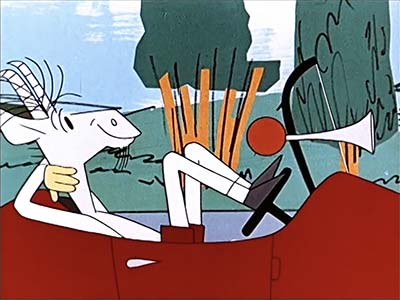
Koziolek Matolek ep04: Rally![]()
Ryszard Slapczynski / Studio Miniatur Filmowych, Poland / 1969
Now we shift from Russia to Poland. Studio Miniatur Filmowych in Krakow was established in 1958, and since then it has produced nearly 1,500 animated films. This series, titled The Strange Adventures of Koziolek Matolek was produced between 1969 and 1971 and 26 episodes were made. The current episode is titled "Rally". We will be sharing more of these in upcoming Reference Packs.
Koziolek Matolek was created in 1933 as a character in Polish comic books. The idea behind the character is a bit surreal, and might seem odd to us in America… Koziolek Matolek is a goat who undertakes a quest to find Pacanow, a town where he has heard that they make shoes for goats. His travels take him to the ends of the Earth and throughout time from the jungles of Africa to medieval Europe to the Wild West. Although the character’s adventures have been well known for generations in Poland and are a staple of children’s literature there, I don’t believe any of the stories, comics or cartoons have ever been translated and distributed outside of that country.
The cartoons were directed by a variety of animators, and the character looks a bit different in each of the individual director’s episodes. The focus is on funny movement and expressions, all while maintaining an admirable level of clarity and economy. This series is a model of what web cartoons could be.
MP4 Video File / SD / 08:48 / 286 MB Download
More members mean we can bring you more special downloads.
JOIN TODAY To Access Members Only Content

Animation Resources is asking our membership to consider donating to help us establish a video podcasting studio to be able to present seminars, interviews and informal updates live streamed on YouTube and Facebook. Our goal is for 25 of our members and supporters to donate $100. If you donate $100, we will provide you with a coupon code for a free membership to give as a gift to a friend or peer, or we can credit your donation to sponsor two students for a one year student membership.
By helping others, you help yourself.

Please consider donating using the PayPal Donate Button below. For more information on our Video Podcasting Fundraiser, see the article Animation Resources Needs Your Help.
![]()
![]() Animation Resources depends on your contributions to support its projects. Even if you can’t afford to donate $100 or join our group right now, please click the button below to donate whatever you can afford using PayPal. Every little bit helps.
Animation Resources depends on your contributions to support its projects. Even if you can’t afford to donate $100 or join our group right now, please click the button below to donate whatever you can afford using PayPal. Every little bit helps.

Or you can donate on Facebook, here…
FACEBOOK LIVESTREAM FUNDRAISER
After you have donated, drop us an email at sworth@animationresources.org and let us know if you would like a discount code for a free membership, or if you would like us to sponsor students with your donation.
Raising the bar with our live streaming initiative will make things better for the whole art form. Don’t stay on the sidelines. Be a part of Animation Resources and join our team to build the foundation for the future of animation.
















